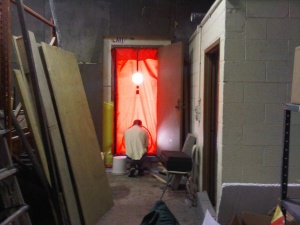Blower Door Test
From Green Garage Detroit
return to Sustainability Labs
return to Current Labs Summary
Contents
Blower Door Test
Goals of Lab
- Determine if we met our air leakage design criteria of 0.1 AC/hr leakage rate.
- Verify general effectiveness of sealing of building envelope with construction now complete.
- Measure potential energy and comfort impact of a window being left cracked open to try to inform occupants.
Decisions to be made from Lab
- Determine if any additional sealing or gasketing is required.
Expected Outcomes
- Determine a value for our overall building leakage (or at least observe leakage with smoke tracer if unable to measure).
- Provide educational information to building occupants on the effects of leaving windows open.
Methodology
General
- No occupants opening/closing doors/windows in building (SEND OUT NOTICE AHEAD OF TIME FOR TEST).
- Seal up any openings between Annex and Historic Building (CHECK WITH KEN; Kirsten has visquine).
- Seal up damper openings in exterior wall with visquine because pressure measurement so low.
- Seal openings for conduits/wires/pipes in wall between Annex and Historic.
- Seal ductwork openings between Annex and Historic.
- Make sure basement is segregated from rest of building; area is excluded from test.
- Start out sealing gaps in doors and windows. Incrementally test envelope construction, door/window gaps, then open window to observe impact.
- Prefer to perform test on low/no wind day (CHECK WEATHER).
- Building air systems off initially and sealed closed at outside envelope.
- Consider putting differential pressure meters in multiple locations (use blower door test apparatus meter, digital micro-manometer, magnehelic gauge). Calibrate meters together first to check for differences.
- Use building exhaust system as alternate approach if pressure differential from testing apparatus inadequate.
Process Measurements
- Record outside conditions; temp/RH/barometric pressure/wind speed & direction/conditions
- Record inside conditions; temp/RH
- Building pressure differential (Kenco equipment; LLC meters).
- Building leakage pressure (Kenco equipment then convert to CFM; otherwise bldg. equip CFM with smoke tracer).
- Use smoke tracer to check for leakage locations.
Resources Required
- Equipment for Test
- Blower Door Test Apparatus - Kenco
- TSI Digital Manometer - LL Catey
- Magnehelic Gauge - LL Catey
- GG DDC Online
- Media to Document
- Measurement recording: test form (LLC check with KEN or create)
- Video - Flip camera USL
- Photos - Canon camera USL
Participants
- Byczinski, Kenco - Perform test
- Catey - Labs POC
- Library (USL) - assist with media (Flip, camera)
- Interested participants:
- Helen - photos, etc.
- Peggy - videographer
- Kirsten (not on Wednesday)
- Michael Paciero
Collaboration
- USL - media
- Kenco - conducting testing
Help Wanted
- Open to observers
Scheduling & Sequencing
- Sequencing/Prerequisites
- No occupants opening/closing doors or windows during test.
- Ventilation systems must be balanced.
- Must have control of ventilation systems.
- Scheduling
- Experiment design - 9/23/2011
- Conduct field testing - TENTATIVE October 6, 2011 between 12 - 2 p.m.
References
- Experiment Tracker - summary of all experiments & experiment project management
- Experiment Template - report template for actual conducting of experiment
Questions
- Is there other test equipment that might handle the size of our building? Could multiple test apparatus achieve our pressure difference?
TO DO
- Plan / Do / Check / Act / Repeat
- Research blower door testing online to find if any other conditions/process requirements.
- [Blower Door Info] - temperature, barometric pressure affect test - correction factor
- Calculate the CFM for Annex and Historic Bldg corresponding to 0.1 AC/hr.
- Review experiment process - group, Ken
- Confirm October 6, 2011 12-2 p.m. okay with Ken
